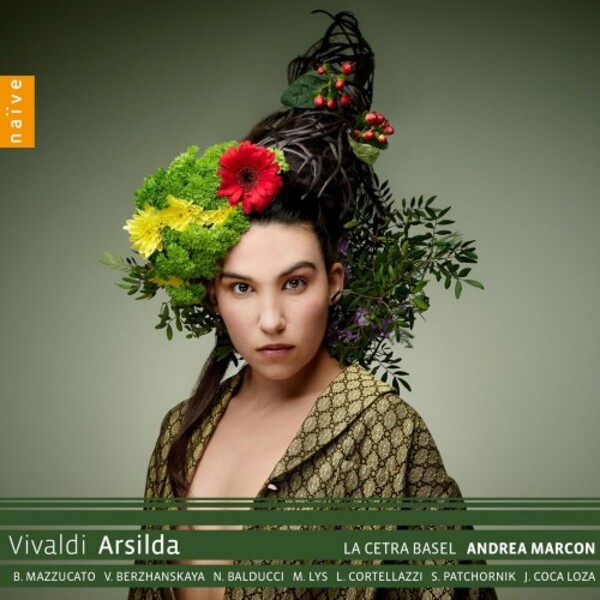VIVALDI Arsilda, regina di Ponto (Marcon)
View record and artist detailsRecord and Artist Details
Genre:
Opera
Label: Naïve
Magazine Review Date: 06/2025
Media Format: CD or Download
Media Runtime: 187
Mastering:
DDD
Catalogue Number: OP8676

Tracks:
| Composition | Artist Credit |
|---|---|
| Arsilda, regina di Ponto |
Antonio Vivaldi, Composer
Andrea Marcon, Conductor, Harpsichord Benedetta Mazzucato, Arsilda, Queen of Pontus, Mezzo soprano José Coca Loza, Cisardo, Bass La Cetra Basel Leonardo Cortellazzi, Tamese, Tenor Marie Lys, Mirinda, Soprano Nicolò Balducci, Barzane, King of Lydia, Male Soprano Shira Patchornik, Nicandro, Soprano Vasilisa Berzhanskaya, Lisea, Mezzo soprano |
Author: David Vickers
Arsilda, regina di Ponto (1716) is a drama of confusion revolving around disguised twins. Lisea has been told that her brother Tamese (heir to the throne of Cilicia) has perished at sea, so she announces her own death and impersonates her brother in order to preserve the throne – which means that she finds herself having to marry Queen Arsilda of Pontus. To make things even more awkward, Lisea was engaged to Barzane, the king of Lydia, but now, inconveniently, he has become obsessed with Arsilda. He and his soldiers sneak into the city to abduct Arsilda but she is rescued heroically by Tamese – who survived and has returned incognito as a lowly gardener. Lisea’s servant and confidante Mirinda falls in love with this mysterious gardener, who in due course reveals his true identity to Arsilda. Meanwhile, Lisea (still masquerading as her brother) guilt-trips Barzane and wins him back. There are multiple levels of irony and deliberately knowing insinuations galore as true identities are gradually restored. Eventually, Lisea confesses that her cross-dressing treason came from a well-intentioned place (and under pressure from the twins’ mother), and there is a double marriage ceremony: Arsilda to the real Tamese and Lisea to the reformed Barzane.
Two manuscript scores bound together in Turin’s Biblioteca Nazionale contradict each other in 13 scenes. The only previous recording of Arsilda, conducted by Federico Maria Sardelli, adopted Vivaldi’s numerous substitutions and cuts made during preparations for the premiere. Naïve’s Vivaldi Edition reinstates four arias cut before the first performance and prefers Arsilda’s rejected first aria (the buoyant ‘Del goder la bella speme’) to its dissimilar sarabande replacement. La Cetra Basel, directed from the harpsichord by Andrea Marcon, reveal fully Vivaldi’s fantastic imagination. The opening chorus featuring trumpets and a dozen supernumerary singers is performed splendidly (Marcon adds thundering timpani), there are braying horns in a ceremony presenting a golden arrow in the temple of Vulcan, and various novel tricks are unleashed in a bizarre hunting divertissement.
Vasilisa Berzhanskaya’s Lisea is by turns blithe, whimsical (attempting to define love to her nonplussed confidante Mirinda) or melancholic (her third-person description to Barzane of her own grieving broken heart); a soliloquy expressing guilt at her public impersonation of her supposedly dead brother is a turbulent tour de force with plunging strings in F minor alluding to hellish whirlpools (‘Di cariddi li vortici ondosi’). Tamese’s lonely lament that his sister appears to have usurped both his throne and marriage is rendered with muscular flexibility by Leonardo Cortellazzi, yet there is lyrical softness supported by velvety violins in ‘La mia gloria ed il mio amore’. Arsilda’s smitten adoration for the mysterious gardener who rescues her (and who oddly resembles her fiancé) is sung gleefully by Benedetta Mazzucato – but later on the visiting queen of Pontus plunges into a tormented abyss of uncertainty in a vivid C minor fast aria that has falling chromatic passages handled marvellously by Mazzucato and La Cetra’s string band (‘Precipizio è del mio petto’). Barzane’s maniacal anticipation that he will ravish the shackled Arsilda is acted giddily by Nicolò Balducci; the penitent villain’s optimism in ‘Quel usignuolo’ uses virtuosic trilling rapid notes for voice and violin to illustrate the double simile of a friendly murmuring breeze and a faithful nightingale.
Marie Lys’s contoured phrasing, stylishness and light agility in Mirinda’s ‘Io son quel gelsomino’ floats beguilingly over a mixture of muted and pizzicato strings, divided violas and concertante harpsichord. Nicandro’s florid evocation of morning dew releasing perfume from a flower in ‘Quando sorge in ciel l’aurora’ is sung brilliantly by Shira Patchornik. José Coca Loza navigates wide vocal leaps with admirably precise bluster to convey Cisardo’s reeling shock in ‘Quale a l’onte de’ venti sul monte’ – a tempestuous gigue with quick-fire imitations between a pair of oboes and violins. This is among the Vivaldi Edition’s most satisfying operatic instalments, thanks to its fusion of exceptional music-making and theatrical conviction.
Discover the world's largest classical music catalogue with Presto Music.

Gramophone Digital Club
- Digital Edition
- Digital Archive
- Reviews Database
- Full website access
From £8.75 / month
Subscribe
Gramophone Full Club
- Print Edition
- Digital Edition
- Digital Archive
- Reviews Database
- Full website access
From £11.00 / month
Subscribe
If you are a library, university or other organisation that would be interested in an institutional subscription to Gramophone please click here for further information.




